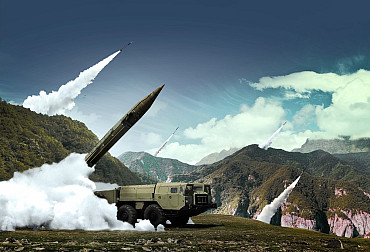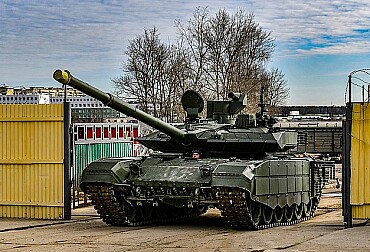Russia's Defense Industry Collapse: Putin's War Machine Faces Its Gravest Crisis Since Soviet Fall
The Russian defense industry, once a formidable pillar of Soviet and post-Soviet military power, is experiencing what internal assessments describe as its deepest crisis since the collapse of the USSR. As Russia enters its fourth year of full-scale war against Ukraine, the country's military-industrial complex is buckling under the combined weight of Western sanctions, workforce depletion, financial insolvency, and sustained Ukrainian counterattacks on production facilities.

The Perfect Storm: Multiple Crisis Vectors Converge
The current crisis represents a convergence of unprecedented challenges that have fundamentally altered the operational landscape for Russian defense manufacturers. Unlike previous economic downturns or isolated sanctions regimes, the current situation presents a multi-dimensional threat that attacks every aspect of the defense production ecosystem simultaneously.
Workforce Devastation and Labor Crisis: The mobilization of Russian forces has created a catastrophic labor shortage across the defense sector. Skilled workers who spent years mastering complex manufacturing processes have been drafted into military service, with many never returning to their workstations. The human cost of the war has directly translated into production line shutdowns and quality control failures. The impact on human resources includes mass mobilization depleting skilled technical workers, combat casualties permanently removing experienced personnel, and a significant "brain drain" as qualified workers flee the country. Training gaps are evident as new workers lack institutional knowledge, and age demographics skew toward an older, less adaptable workforce. The loss of institutional knowledge represents a particularly severe long-term challenge, as manufacturing complex weapons systems requires accumulated experience in troubleshooting, quality control, and process optimization that cannot be easily replaced.
Financial Insolvency Across the Sector: Perhaps most critically, Russian defense enterprises are operating in what industry insiders describe as "manual control" mode – a euphemism for crisis management where normal business operations have been suspended in favor of emergency measures. The fundamental economics of defense production have been shattered. Financial crisis indicators include below-cost pricing mandated by government contracts, multi-year payment delays freezing company cash flow, and an export revenue collapse eliminating profit margins. Supplier payment defaults are disrupting supply chains, and court cases are proliferating as companies pursue unpaid debts. The case of Uralvagonzavod, Russia's largest tank manufacturer, exemplifies the sector-wide crisis. Despite massive military demand, the company has announced personnel reductions due to insufficient funds – a paradoxical situation that highlights the dysfunctional nature of current defense economics.
Sanctions: The Slow Strangulation of Supply Chains: Western sanctions have created what defense industry managers describe as a "slow strangulation" of production capabilities. Unlike immediate embargos, the current sanctions regime creates cascading failures that compound over time, making each production cycle more difficult and expensive than the last. Sanctions impact categories include critical components becoming unavailable or prohibitively expensive, raw materials facing supply disruptions and quality degradation, and severe shortages of technical fluids and coatings. Electronics and semiconductors require inferior substitutes, and manufacturing equipment lacks maintenance and replacement parts. Internal correspondence reveals that imported component costs have increased "in tens of times or even a hundred," creating unsustainable cost structures that make profitable operations impossible even with inflated government contracts.
Corporate Casualties: Major Enterprises in Distress
Specific examples illustrate the systemic nature of the crisis affecting key Russian defense manufacturers.
Kronstadt: Drone Manufacturer Under Legal Siege: Kronstadt, Russia's premier unmanned aerial vehicle manufacturer specializing in the Orion reconnaissance-strike platform, has become emblematic of the sector's financial distress. The company faces over 600 million rubles ($7 million) in debt claims since summer 2024, with major creditors including LLC Innovative Technologies (151.1 million rubles) and AO Research Institute of Modern Telecommunications Technologies (220.6 million rubles), along with multiple smaller suppliers. This legal avalanche reflects the broader pattern of cascading payment failures throughout the defense supply chain, where government payment delays create domino effects of corporate insolvency.
United Aircraft Corporation: Aviation Giant Grounded by Debt: The United Aircraft Corporation (UAC), responsible for Russia's combat aircraft production including the Su-35, Su-57, and strategic bombers, faces its own financial crisis. The corporation is entangled in hundreds of court cases seeking debt compensation, while simultaneously struggling to meet production quotas for critical military aircraft. The UAC's predicament illustrates how export market losses have devastated the financial foundations of Russian defense manufacturing. Previously, high-margin international sales subsidized below-cost domestic deliveries, but sanctions and buyer withdrawals have eliminated this crucial revenue stream.
Murom Instrument-Making Plant: Trapped in Financial Quicksand: Internal correspondence from the Murom Instrument-Making Plant reveals the impossible mathematics facing defense contractors. The facility must deliver products at prices fixed in 2019 while purchasing components at current market rates with prepayment requirements – a formula that guarantees losses on every transaction. Specific financial distress includes 70 million rubles in losses on navigation system "Product 1T146," 3-5 year payment delays on completed contracts, insufficient state funding to cover loan interest payments, and an inability to reinvest in production improvements or capacity expansion.
The Export Market Collapse: Severing Financial Lifelines
For decades, Russian defense enterprises operated on a dual-market model where high-margin export sales compensated for below-cost domestic deliveries. This system allowed companies to maintain profitability while fulfilling government contracts at subsidized prices. The collapse of export markets has eliminated this crucial financial mechanism.
Lost International Contracts: Major export losses include Egypt's Su-35 cancellation (a multi-billion dollar fighter jet deal abandoned), India's shipbuilding withdrawal (naval contracts terminated due to component shortages), and disruption in the African market, where traditional buyers are unable to complete transactions. Asian clients show hesitation due to concerns about sanctions compliance and spare parts availability, while Latin American deferrals are common as payment mechanisms are disrupted by banking restrictions.
Sanctions on Financial Infrastructure: International banking sanctions have made even willing buyers unable to complete transactions. Traditional payment mechanisms through SWIFT and correspondent banking relationships have been severed, leaving Russian exporters without practical means to receive payment for delivered goods.
Ukrainian Pressure: Direct Attacks on Production Capacity
Ukraine's systematic campaign against Russian defense infrastructure has added a kinetic dimension to the industrial crisis. Beyond economic and financial pressures, Ukrainian forces are directly degrading Russia's production capabilities through targeted strikes and sabotage operations.
Strategic Targeting Campaign: Ukrainian attack patterns include direct strikes on manufacturing plants, disruption of component and finished goods transportation at logistics hubs, attacks on petroleum facilities essential for production, sabotage of critical railway network supply connections, and destruction of component and raw material stockpiles at storage facilities.
Intelligence Operations: Ukrainian intelligence services have developed sophisticated penetration capabilities within Russian defense facilities, enabling both information gathering and sabotage operations. These efforts have complicated security protocols and increased operational costs while reducing production efficiency.
Import Substitution Failures: Domestic Alternatives Fall Short
Russia's attempts at import substitution – replacing Western components with domestic or allied-nation alternatives – have consistently failed to meet operational requirements. This failure stems from both technological gaps and insufficient production capacity among substitute suppliers.
Quality Control Disasters: Substitution challenges include Chinese components providing inferior performance characteristics, domestic alternatives lacking reliability and precision, and Iranian cooperation limited to specific technology areas. North Korean supplies are restricted to basic ammunition and components, and Indian partnerships are constrained by Western pressure.
Technological Dependencies: Critical systems like thermal imaging, advanced electronics, precision manufacturing equipment, and specialized alloys remain dependent on Western technology that cannot be easily replicated or substituted. These dependencies create bottlenecks that limit production regardless of available funding or raw materials.
Government Response: Throwing Money at Structural Problems
The Russian government's response to the defense industry crisis has focused primarily on increased funding and subsidies rather than addressing underlying structural problems. This approach has proven insufficient to overcome the combination of sanctions, workforce shortages, and technological dependencies.
Budgetary Strain: Government financial pressures include defense spending consuming increasing portions of the federal budget, subsidy requirements growing faster than available resources, and competing priorities including social spending and infrastructure. Revenue constraints due to energy export limitations and inflation pressures further reduce the purchasing power of allocated funds.
Centralized Control Limitations: Russia's centralized decision-making structure has proven poorly adapted to the rapid problem-solving required in the current crisis. Multi-year contract cycles, bureaucratic approval processes, and rigid pricing mechanisms prevent the flexibility needed to address supply chain disruptions and market changes.
Global Implications: Reshaping International Defense Markets
The collapse of Russian defense industry capabilities has profound implications for global security dynamics and international arms markets. Traditional buyers of Russian equipment face spare parts shortages and maintenance challenges, while competing suppliers rush to fill market gaps.
Market Redistribution: Global market changes include Chinese manufacturers expanding into traditional Russian markets, Western suppliers gaining new customers among former Russian clients, and regional powers developing indigenous capabilities to reduce import dependence. Technology transfer is accelerating as buyers seek supply chain diversification, and price dynamics are shifting as Russian equipment loses competitiveness.
Strategic Realignments: Countries that previously relied on Russian defense equipment are being forced to diversify their military procurement, leading to new strategic partnerships and alliance structures. This shift has implications for regional balance of power and international security arrangements.
Long-term Consequences: A Decade of Decline Ahead
The current crisis represents more than a temporary downturn – it signals the beginning of what may be a decade-long decline in Russian defense industrial capabilities. The combination of technological isolation, workforce depletion, and financial constraints creates a negative feedback loop that will be difficult to reverse.
Technological Stagnation: Innovation barriers include research and development funding being diverted to immediate production needs, international cooperation severed by sanctions and political isolation, and brain drain removing innovative talent from the sector. Equipment obsolescence is a growing concern as Western manufacturing tools become unmaintainable, leading to quality degradation as inferior components become standard.
Competitive Disadvantage: Russian defense products are increasingly uncompetitive in international markets due to reliability concerns, spare parts availability issues, and sanctions compliance risks for buyers. This trend is likely to accelerate as alternative suppliers improve their offerings and expand production capacity.
Regional Security Implications: The degradation of Russian defense industrial capacity has significant implications for regional security dynamics, particularly in Eastern Europe, the Middle East, and Central Asia where Russian equipment has traditionally dominated military inventories. Strategic realignments include NATO expansion accelerated by the reduced Russian military threat, partnership diversification as traditional Russian allies seek alternative suppliers, regional powers increasing indigenous defense capabilities, technology sharing agreements expanding among Western allies, and collective security arrangements strengthening in response to Russian weakness. The industrial crisis may paradoxically extend the Ukraine conflict as Russia becomes unable to achieve decisive military victories but remains committed to territorial gains. This scenario could lead to prolonged, lower-intensity warfare that drains resources without achieving strategic objectives.
Economic Transformation: From Defense Giant to Industrial Liability
Russia's defense sector transformation from economic asset to liability represents one of the most significant industrial collapses in modern history. The sector that once generated substantial export revenues and supported hundreds of thousands of high-skilled jobs has become a drain on state resources with diminishing strategic value.
Structural Unemployment: The defense industry's decline will create massive structural unemployment in regions heavily dependent on military manufacturing. Cities like Tula, Nizhny Novgorod, and Yekaterinburg face potential economic devastation as defense plants reduce operations or close entirely.
Regional Development Crisis: Regional impact includes single-industry towns facing economic collapse, infrastructure decay as defense plants reduce maintenance spending, population exodus from affected regions, tax base erosion reducing local government capabilities, and social services strain as unemployment increases.
International Response and Future Scenarios
The international community's response to Russia's defense industry crisis will significantly influence both the conflict's trajectory and long-term global security arrangements. Current policies appear designed to maintain pressure while avoiding complete industrial collapse that might create unpredictable security risks.
Sanctions Calibration: Policy considerations include graduated pressure maintaining economic stress without triggering desperation, humanitarian exceptions preventing civilian infrastructure collapse, allied coordination ensuring consistent international pressure, exit ramps providing potential pathways for conflict resolution, and long-term planning for post-conflict reconstruction and reintegration.
Strategic Planning Implications: For Western defense planners, Russia's industrial decline creates both opportunities and risks. Reduced Russian military capabilities may enable force redeployments to other regions, but industrial desperation might also lead to more aggressive or unpredictable Russian behavior.
Conclusion: The End of an Era
The crisis engulfing Russia's defense industry marks the end of an era in which Russian military technology commanded global respect and generated substantial export revenues. The combination of sanctions, workforce depletion, financial insolvency, and direct attacks has created a perfect storm that appears unlikely to be weathered without fundamental structural changes.
The immediate implications are clear: reduced Russian military capabilities, extended conflict duration in Ukraine, and significant disruption to global defense markets. However, the long-term consequences may be even more profound, potentially reshaping international security architecture and regional power balances for decades to come.
As Russia's defense industry continues its decline, the international community faces critical decisions about maintaining pressure while managing the risks associated with a desperate and increasingly isolated nuclear power. The outcome of this industrial crisis will likely determine not only the fate of the Ukraine conflict but the broader trajectory of 21st-century international relations.
The collapse of Russia's defense industry represents more than an economic phenomenon – it signals a fundamental shift in global power dynamics that will reverberate through international relations for generations to come. Understanding and responding to this transformation will be among the most critical challenges facing policymakers in the years ahead.









